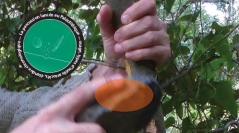

 Comptes Rendus Palevol
21 (8) - Pages 175-189
Comptes Rendus Palevol
21 (8) - Pages 175-189Level US4 of the Bois-de-Riquet archeological site represents a mudslide type deposit dating to the early Middle Pleistocene. It has yielded a rich lithic assemblage made from basalt, aplite and quartz, whose components represent all of the operating chains of production: cores, flakes, hammers, worked cobbles and blocks, as well as a biface. The latter, associated with the production of large flakes, testifies to the first phases of the European Acheulian. This article presents the analysis of part of the macro-tools made from basalt. The methodology is based on a techno-morpho-functional and traceological analysis of the artefacts, coupled with the creation of a specific experimental frame of reference. These approaches allow us to distinguish among five tool types. Three groups of tools present a transverse opposition between their cutting edges and gripping zones, while the other two groups present an oblique opposition. These functional structures refer to different gestures. However, the size and weight characteristics of the artefacts, as well as the angle of the cutting edges, allow us to propose a mode of action in direct launched percussion. This hypothesis was experimentally tested on wood and fresh bone to verify, on the one hand, the effectiveness of these tools for these activities and, on the other hand, to analyze the damage produced on the cutting edges and compare it to the archeological tools. The data obtained experimentally support the hypothesis that launched percussion was used in these five groups of sharp-edged macro-tools. We discuss the implications of these results for the characterization of the first phases of the European Acheulean. Indeed, beyond the presence of a biface, the production of massive flakes as tool supports may be perceived as a technological innovation in Europe, possibly characterizing an evolution of cognitive order. At the same time, the use of these sharp tools in launched percussion could indicate that hominins were exploiting their environments in new ways. Finally, this article brings new elements of reflection to the debate on the origins of the European Acheulean.
Large cutting tools, launched percussion, Early European Acheulian, France